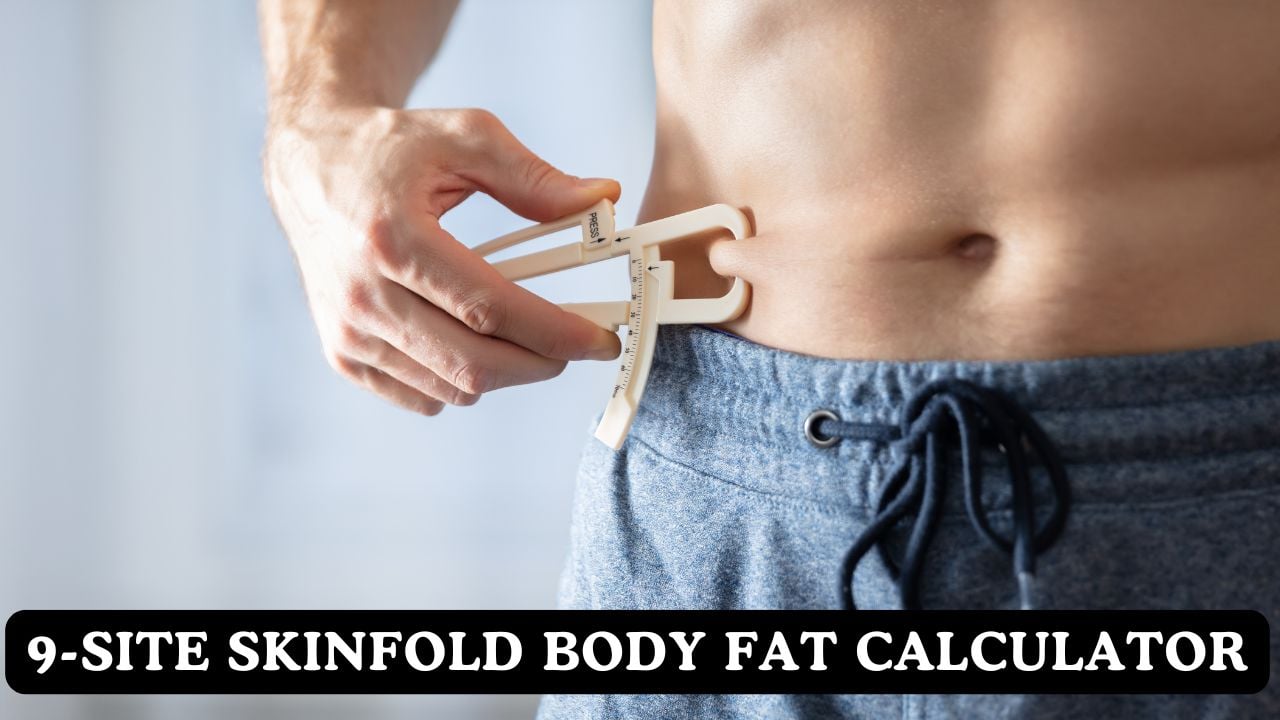9-Site Skinfold Body Fat Calculator
Comprehensive Parrillo method for detailed body composition assessment using nine strategic measurement sites

9-Site Skinfold Body Fat % (Parrillo Skinfold)
The Parrillo 9-site skinfold method provides the most comprehensive body fat assessment available through skinfold calipers. By measuring nine strategic anatomical locations, this method captures body fat distribution patterns that shorter protocols might miss. This comprehensive approach is particularly valuable for athletes, bodybuilders, and fitness enthusiasts who need detailed body composition insights. For additional body composition resources and visual guides, explore our complete collection at Body Fat Percentage Chart on Fit Life.
🔬 Scientific Foundation
The Parrillo method was developed by John Parrillo specifically for competitive bodybuilding, using a simple formula that relates skinfold sum to body weight. Unlike scientifically validated equations (Jackson-Pollock, Durnin-Womersley), the Parrillo method doesn’t account for gender, age, or population-specific differences. Research indicates that while increasing measurement sites can improve accuracy, the calculation method itself significantly impacts validity.
📊 Enhanced Precision
The nine measurement sites capture fat distribution across major body regions: upper body (chest, triceps, biceps), trunk (abdomen, subscapular, suprailiac, midaxillary), and lower body (thigh, calf). This comprehensive sampling provides insights into regional fat storage patterns, which can be particularly valuable for tracking progress during body recomposition phases. However, the Parrillo formula’s simplicity means it doesn’t account for individual differences in body composition, potentially limiting accuracy compared to validated equations.
Complete 9-Site Measurement Guide
💪 Chest (Pectoral) Technique
Location: Diagonal fold halfway between anterior axillary line and nipple
Method: Pinch skin following natural skin line, approximately 45° angle
Direction: Diagonal fold running toward armpit
Tips: Ensure consistent placement between measurements
🫃 Abdomen Technique
Location: Vertical fold 2cm to the right of umbilicus
Method: Pinch skin vertically, avoid muscle contraction
Direction: Vertical fold parallel to body midline
Tips: Take measurement during normal breathing, not flexed
🦵 Thigh (Anterior) Technique
Location: Vertical fold on anterior thigh, midway between hip and knee
Method: Subject standing, weight on opposite leg
Direction: Vertical fold parallel to thigh axis
Tips: Locate true midpoint between inguinal crease and patella
💪 Triceps Technique
Location: Vertical fold on posterior arm, midway between shoulder and elbow
Method: Arm relaxed at side, measure over muscle belly
Direction: Vertical fold parallel to arm axis
Tips: Ensure arm is completely relaxed during measurement
🔙 Subscapular Technique
Location: Diagonal fold 1-2cm below inferior angle of scapula
Method: Follow natural skin line, approximately 45° to horizontal
Direction: Diagonal fold running medially downward
Tips: Subject should stand relaxed with arms at sides
🦴 Suprailiac Technique
Location: Diagonal fold above iliac crest along anterior axillary line
Method: Follow natural skin line above hip bone
Direction: Diagonal fold following skin contour
Tips: Locate the anterior axillary line accurately for consistency
🫁 Midaxillary Technique
Location: Vertical fold on midaxillary line at xiphoid process level
Method: Pinch skin on side of torso at bottom of sternum level
Direction: Vertical fold parallel to body axis
Tips: Use xiphoid process as anatomical landmark
💪 Biceps Technique
Location: Vertical fold over belly of biceps muscle
Method: Arm relaxed, measure at maximum muscle bulk
Direction: Vertical fold parallel to arm axis
Tips: Ensure biceps is completely relaxed, not contracted
🦵 Calf (Medial) Technique
Location: Vertical fold at maximum circumference of calf on medial side
Method: Subject standing, pinch skin on inside of calf
Direction: Vertical fold parallel to leg axis
Tips: Locate point of maximum calf circumference for consistency
Measurement Protocol & Best Practices
Pre-Measurement Preparation
- Use high-quality skinfold calipers (Lange, Harpenden, or Accu-Measure)
- Ensure subject is well-hydrated but not immediately post-exercise
- Room temperature should be comfortable (20-24°C)
- Mark all nine measurement sites before beginning
- Take measurements on the right side of the body only
Measurement Technique
- Pinch skin firmly between thumb and forefinger
- Place caliper jaws 1cm below fingers, perpendicular to fold
- Apply consistent pressure (10g/mm²)
- Read measurement 2 seconds after full pressure is applied
- Take 2-3 measurements at each site, use median value
- Rotate through all sites rather than completing one site at a time
Step 1: Sum All Nine Measurements
Add chest + abdomen + thigh + triceps + subscapular + suprailiac + midaxillary + biceps + calf (in millimeters)
Step 2: Apply Parrillo Formula
The actual Parrillo equation:
Body Fat % = (Sum of 9 skinfolds in mm × 27) ÷ Body Weight in lbs
Important Limitations
- Does not account for gender differences in fat distribution
- Does not factor in age-related body composition changes
- May overestimate body fat by approximately 4.7%
- Less accurate for very lean or very heavy individuals
Body Fat Standards & Categories
| Category | Men (18-29) | Men (30-49) | Men (50+) | Women (18-29) | Women (30-49) | Women (50+) |
|---|---|---|---|---|---|---|
| Essential Fat | 3-5% | 3-5% | 3-5% | 10-13% | 10-13% | 10-13% |
| Athletes | 6-13% | 7-16% | 9-18% | 14-20% | 16-23% | 18-27% |
| Fitness | 14-17% | 17-19% | 19-21% | 21-24% | 24-27% | 27-30% |
| Average | 18-24% | 21-27% | 24-29% | 25-31% | 28-34% | 31-37% |
| Above Average | 25%+ | 28%+ | 30%+ | 32%+ | 35%+ | 38%+ |
Note: These ranges provide general guidelines for body fat categories. Individual variation exists due to genetics, ethnicity, training status, and body composition. Competitive athletes may have body fat percentages outside these ranges while maintaining excellent health. For comprehensive visual references and additional context, visit our Visual Body Fat Percentage guide on Fit Life.
Method Comparison & Applications
Parrillo vs. Other Skinfold Methods
The Parrillo 9-site method provides more comprehensive coverage than traditional 3-site or 7-site protocols. While research shows diminishing returns beyond seven sites, the additional measurements can be valuable for tracking regional fat distribution changes. The method is particularly popular in bodybuilding and physique sports where detailed body composition monitoring is crucial for competition preparation.
Bodybuilding & Athletic Applications
John Parrillo developed this method specifically for competitive bodybuilders who need precise body composition tracking. The nine-site approach captures fat distribution patterns across all major body regions, making it valuable for identifying stubborn fat areas and monitoring progress during cutting phases. Studies indicate that skinfold methods remain practical for athletic populations despite newer technologies.
Accuracy Limitations & Practical Considerations
The Parrillo method’s main limitation is its potential to overestimate body fat by approximately 4.7% compared to validated methods. The formula’s simplicity (not accounting for gender/age differences) makes it less accurate than research-validated equations. While comprehensive in measurement sites, users should consider validated 3-site or 7-site Jackson-Pollock equations for more accurate results, especially in research or clinical settings.
Professional Tips & Optimization
Measurement Precision
Mark all nine sites before beginning measurements. Use anatomical landmarks for consistent placement. Take multiple readings per site and use the median value for best accuracy.
Timing Consistency
Take measurements at the same time of day, preferably morning after bathroom use. Avoid measurements immediately after exercise or during dehydration.
Equipment Quality
Use research-grade calipers (Lange, Harpenden, or Accu-Measure). Calibrate regularly and replace worn springs. Digital calipers can improve consistency.
Progress Tracking
Focus on trends rather than single measurements. Body fat changes slowly – monthly assessments provide better insights than frequent testing. Document measurement conditions.
Health & Fitness Integration
🏆 Athletic Performance Optimization
The Parrillo 9-site method excels in athletic and competitive settings where precise body composition monitoring drives performance. Bodybuilders, physique competitors, and endurance athletes use this comprehensive approach to optimize power-to-weight ratios and achieve specific body composition targets. The detailed regional assessment helps identify areas needing focused attention during training phases.
📊 Comprehensive Health Assessment
While primarily developed for athletic applications, the 9-site method provides valuable insights for general health and fitness tracking. The comprehensive measurement approach can detect changes in regional fat distribution that shorter protocols might miss. This detailed analysis supports evidence-based adjustments to nutrition and exercise programs for optimal body composition outcomes.
🔬 Research & Clinical Applications
Research applications benefit from the 9-site method’s comprehensive data collection, particularly in studies examining regional fat distribution patterns or body composition changes during interventions. While more time-intensive than shorter protocols, the additional measurement sites can provide valuable data for understanding individual responses to training and nutrition programs.
⚕️ Medical Disclaimer
This 9-site skinfold calculator uses the Parrillo formula and should not replace professional medical advice. Important: The Parrillo method may overestimate body fat by approximately 4.7% compared to validated methods and does not account for gender, age, or individual physiological differences. Results may vary significantly based on measurement technique, equipment quality, and individual characteristics. The formula was developed for bodybuilding applications and may not be appropriate for general population assessment. For accurate body composition assessment, consider validated Jackson-Pollock equations or professional methods (DEXA, hydrostatic weighing). Consult with healthcare professionals, registered dietitians, or certified fitness professionals before making significant changes to diet, exercise, or lifestyle based on these measurements. Pregnant or breastfeeding women, individuals with eating disorders, or those with medical conditions affecting body composition should seek professional guidance before using these results for health or fitness planning.
References
- Parrillo J, Greenwood-Robinson M: “High-performance bodybuilding” Berkeley Publishing group, New York,169-172, 1993
- Peterson MJ, Czerwinski SA, Siervogel RM. Development and validation of skinfold-thickness prediction equations with a 4-compartment model. The American journal of clinical nutrition. 2003;77(5):1186-91. Epub 2003/04/30.
- Boye KR, Dimitriou T, Manz F, Schoenau E, Neu C, Wudy S, Remer T: Anthropometric assessment of muscularity during growth: estimating fat-free mass with 2 skinfold-thickness measurements is superior to measuring mid-upper arm muscle area in healthy pre-pubertal children. Am J Clin Nutr 2002: 76; 628
- Muntean P, Neagu M, Amaricai E, Haragus HG, Onofrei RR, Neagu A. Using A-Mode Ultrasound to Assess the Body Composition of Soccer Players: A Comparative Study of Prediction Formulas. Diagnostics (Basel). 2023 Feb 12;13(4):690. doi: 10.3390/diagnostics13040690. PMID: 36832176; PMCID: PMC9955205.

Manish is a NASM-certified fitness and nutrition coach with over 10 years of experience in weight lifting and fat loss fitness coaching. He specializes in gym-based training and has a lot of knowledge about exercise, lifting technique, biomechanics, and more.
Through “Fit Life Regime,” he generously shares the insights he’s gained over a decade in the field. His goal is to equip others with the knowledge to start their own fitness journey.
